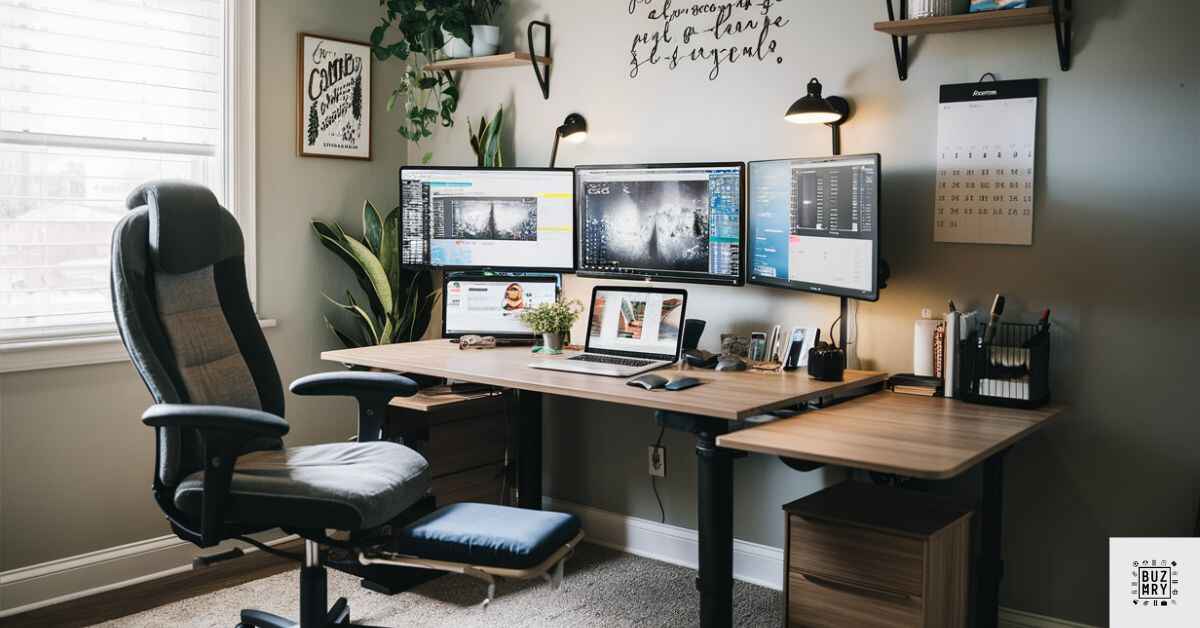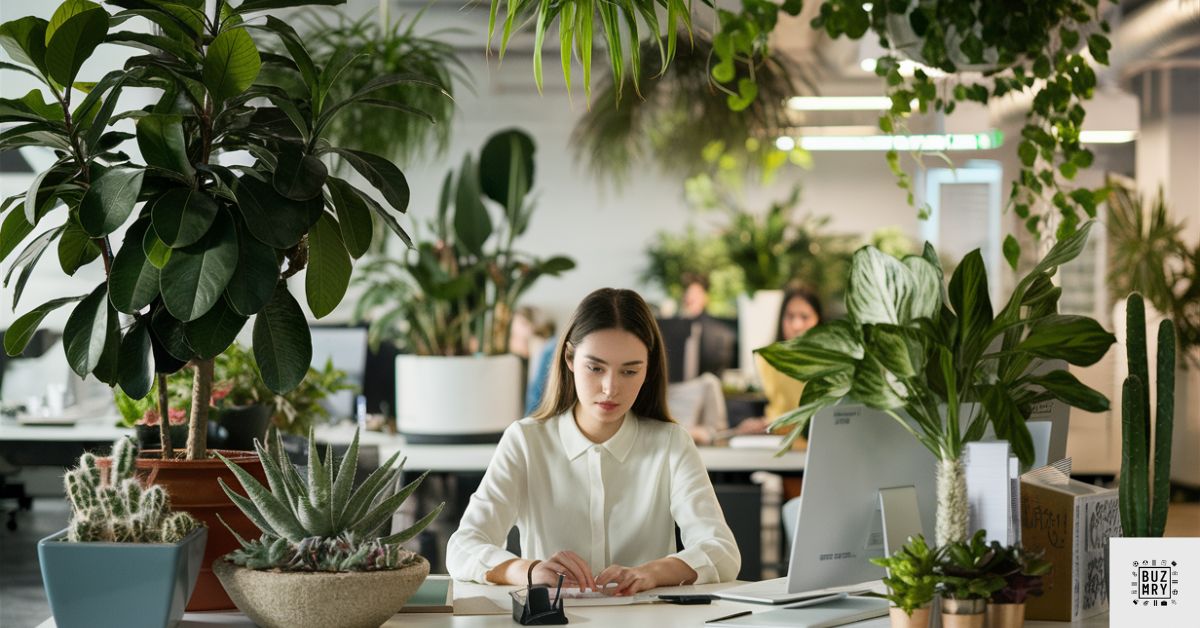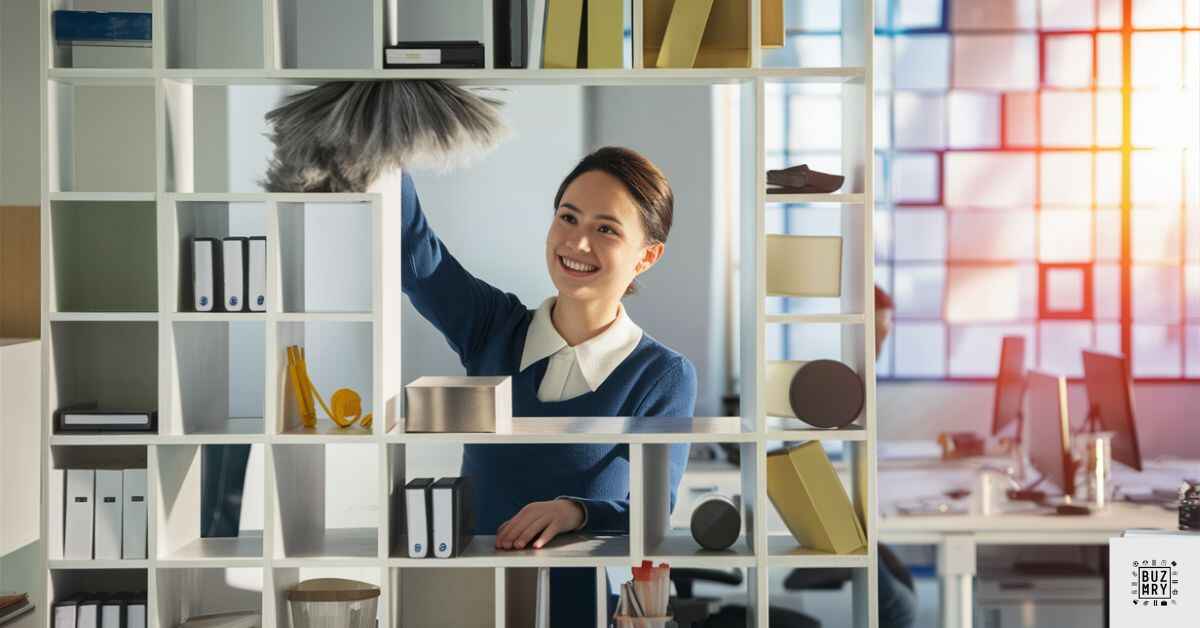When setting up a workspace, it’s essential to focus on back support and adjustable height armrests for comfort. “How to Create a Productive Workspace at Home? – [2024]” will guide you in creating an efficient home office. From choosing the right furniture to minimizing distractions, these tips will help turn your home into a productive environment. It’s time to discover how to create an efficient and comfortable workspace right at home!
Selecting the most appropriate location for a home office

Natural light has the potential to alter your work life. It is establish that if offices are naturally light, productivity can be increase by as much as 40%. Here is how to maximize your chance of doing so.
- Plan to put your desk close to the window to let some fresh air in, but ensure your screen does not glare.
- For light control, they should use a curtain to filter direct sunlight and prefer light-colored curtains.
- For dark days or rooms, a light therapy lamp can be recommend.
- To alter the quality of the light during the day; fit blinds that can be adjust.
- One suggestion is to use mirrors to bounce natural light and lighten the too-dark areas.
Quiet, Please: Minimizing Distractions
Any distraction that you can think of is in your house. Here is how to create a fortress of focus: Here is how to create a fortress of focus:
- Try to locate where noise is likely coming from within the home and avoid such areas.
- Make sure to put on noise canceling head phone when disruptions is not for seen.
- Create a sign on the door informing other household members not to disturb the patient.
- Select a location far from areas that generate heat and steam, such as the kitchen.
- Some of the recommendation to be make include soundproofing, such as an acoustic panel or a white noise machine.
- Cultivate the culture of stopping all non-vital activities using technology with the family during certain times of the day.
- Attention span determines success since it defines the measure of focus. – Tom Kite
Essential Elements of a Productive Home Workspace

The rewards that will be derive directly from the investment you will make in ergonomic furniture shall be fully reciprocate by your body.
Adjustable chair: Look for back support in the lower back area. Other features include adjustable height armrests.
Standing desk: Standing and sitting exercise shell also be try as much as possible, where they can change from sitting down to standing and vice versa.
Ergonomic keyboard and mouse: It’s about time to brainstorm ways to lessen the stress on the wrist and fingers.
Footrest: ensure that the patient is well position and a good blood supply is provide.
Monitor arm: The laptop must be equip with the ability to rotate the computer screen to reduce stress on the user’s neck muscles.
Anti-fatigue mat: Locate the option for the problem eradicating pain when employed at stationery desks.
Tech Talk, Powering Your Productivity
The proper tech setup can make or break your workday. Essential gadgets include a reliable computer or laptop, a High-speed internet connection, an External monitor for expanded screen real estate, Noise-canceling headphones, a Webcam for video calls, a Printer/scanner combo for document management, a Surge protector to safeguard your equipment, and a Wireless router for stable connectivity. Remember cable management! Use cable clips or a cable tray to keep your workspace tidy.
Organizing Your Home Workspace for Efficiency
Declutter and Conquer
A cluttered space leads to an untidy mind. Embrace minimalism with these tips:
Keep only essential items on your desk.
Use drawer organizers for small supplies.
Invest in a filing system for important documents.
Digitize paperwork when possible.
Implement the “one in, one out” rule for office supplies.
Schedule regular decluttering sessions to maintain order.
Zone Defense: Creating Task-Specific Areas
Divide your workspace into zones for different activities:
Focus Zone: Your primary workstation for deep work.
Collaboration Zone: A comfortable spot for video calls.
Brainstorming Zone: A whiteboard or corkboard for creative thinking.
Recharge Zone: A cozy nook for quick breaks.
Storage Zone: A designated area for files and supplies.
Reading Zone: A comfortable chair for reviewing documents
Personalizing Your Space: Balancing Function and Inspiration
Going Green: Plants in the Workspace

Plants are not just pretty; they can boost productivity by up to 15%. Consider these low-maintenance options.
- Snake Plant
- ZZ Plant
- Potho
- Succulents
- Peace Lily
- English Ivy
Decor That Inspires
Your workspace should reflect your personality and inspire you. Try these ideas:
Hang motivational quotes or artwork. Display personal achievements or goals. Use a vision board to stay focused on long-term objectives. Incorporate your favorite colors in small doses. Add textural elements like a cozy rug or textured wallpaper. Create a gallery wall with inspirational images and quotes.
Read This Blog: The Comprehensive Guide to Smart Square MUSC
Maintaining Work-Life Balance in Your Home Office
Setting Boundaries: The Key to Sanity
When your home is your office, it’s crucial to establish boundaries. When your home is your office, it’s vital to establish boundaries:
The management should agree on certain working hours, and everybody should adhere to them
Establish a “commute” in that one takes five minutes to thirty minutes to walk before and after leaving work.
If you can, employ another line, either telephonic or email, purely for work-related business.
That is why it is essential to establish a shutdown for those who work outside the home to mark the end of the working week.
Employ formal lighting for working periods and casual lighting for other activities.
As a general rule, use a cultural uniform switch you bring from work to personal time.
Move It or Lose It: Movement is the second essential element of a Fitbit user’s life log.
But the sad thing is sitting all day is not suitable for your body and not good for your mind. Try these strategies:
- Spend some hours of your day at the standing desk.
- Schedule yourself for the regular stretch breaks (it will do good to set alarms for this).
- There are tips such as exercising at the desk; one can opt for plank exercises such as leg lifts or seated twists.
- For example, an under-desk treadmill or bike allows employees to exercise lightly while working.
- Sit on a stability ball in the office as a chair during some portions of the workday.
Also Read This Blog: How do you conduct a Maryland Business Entity Search?
The Importance of Regular Maintenance

Keep your home office in top shape with these maintenance tips:
- Clean your workspace daily
- Sanitize high-touch surfaces regularly
- Update software and run virus scans weekly
- Reassess your setup monthly and make adjustments as needed
- Conduct a thorough DE cluttering session quarterly
Frequently Asked Question
How can you prepare a good working environment at home?
Ergonomically correct furniture, lighting, and course are essential for a working environment, and there should be as few distractions as possible. By making the workplace specific to the users, you can make your surroundings more comfortable and enhance your organizational skills.
What measures can one take to enhance home working productivity?
Improve performance by including daily schedules and goals and ensuring employees’ breaks are adequate and healthy. Employ applications such as task management and timers to assist you.
How do I get start or work on my space?
To create your workspace, find a suitable place in your house or apartment, buy the necessary office supplies and equipment, and arrange it properly. Ensure you are in a comfortable position and environment, eliminating anything that may distract you.
I am working from home, setting up productivity in my home office; what should I do?
Working at home, establish your office by selecting comfortable setting solutions, finding the proper spots for lighting, and arranging your working area. Light integration of productivity tools must be adopt, and one must develop a working timetable that will enable the achievement of productivity goals through out the day.
What should a good workplace atmosphere look like?
Paint your working space in soft and warm colors, add greens, and do not let clutter enter the room. Add warm and dim light sources, and arrange things according to how you like them.
I sit down and think about how to arrange the space I use for work at home.
This means that one shell declutter his/her office at home from time to time and organize wherever possible using containers and putting into consideration items that are frequently use shell be readily accessible. Sorting and relabel also enables one to keep items in order.
Conclusion
Many factors help build a productive working environment in the home. First, it is necessary to choose a unique, calm working area that is not contaminate by other noise sources; it is good if it is illuminate in daylight.
Accompany it with proper furniture, like an adjustable computer chair and a proper table if one has to spend hours working on a computer. Arrange the items in the area where they are use often, and organize them properly to reduce the risks of cluttering the space.
It can greatly enhance the quality and efficiency of work and personal health.
As the admin of Buzsmarty.com, I bring a passion for Business, Travel, Entertainment, and Sports. My goal is to deliver fresh insights and updates, helping readers stay informed and entertained. With a keen eye for trends and a commitment to quality content, I strive to make Buzsmarty.com a go-to destination for diverse interests.

![How to Create a Productive Workspace at Home?-[2024]](https://buzsmarty.com/wp-content/uploads/2024/08/How-to-Create-a-Productive-Workspace-at-Home-2024-1024x536.jpg)

